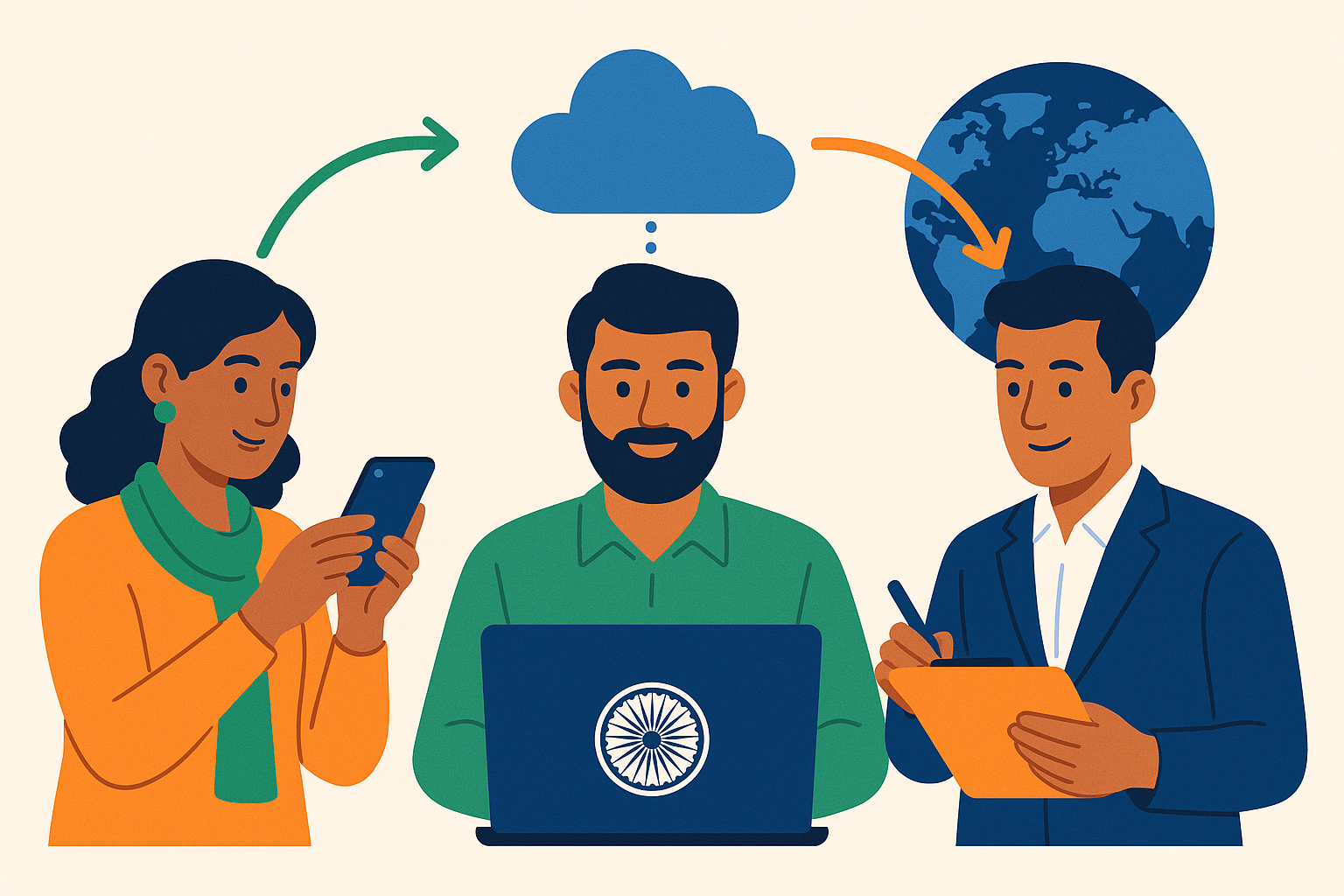Tech Players Are Betting India | 매거진에 참여하세요
Tech Players Are Betting India
#india #gdp #it #salary #appmarket #cost #payment
Why Global Tech Players Are Betting on India — And Why You Should Too
If you're planning global expansion and haven't considered India, you're probably behind.
India isn't just about "population scale" anymore. It's about economic velocity,
digital-first consumption, and a massive, mobile-native generation coming online.
From PUBG’s pivot to BGMI to Spotify’s hyperlocal pricing, companies are learning fast:
India requires localization, but the upside is immense.
Let's break it down.

1. A Sleeping Giant Awakened — India Is Now the World’s 3rd Largest Economy
As of 2024, India’s nominal GDP has surpassed Japan and Germany, standing around $3.7–4 trillion.
That makes it #3 globally, just behind the U.S. and China.
What's driving this?
- A digital payments revolution (thanks to UPI)
- IT service exports ($250–300 billion scale)
- A booming consumer base of 1.4 billion, with over 50% under 25
Aggressive investment in manufacturing and infrastructure
Still, the per capita GDP sits at $2,600–2,700 — placing it firmly in the “emerging” category.
But growth rates of 6–7% a year, combined with digital-native behaviors, signal long-term upside.
2. The Indian IT Engine — Low Salaries, High Output
India’s IT industry isn’t just about outsourcing anymore. It’s about product, SaaS, AI, and platform innovation.
Top service exporters like TCS, Infosys, Wipro are now joined by global SaaS players like Freshworks and Zoho.
Some 5–8 million people work in the tech industry directly or via contract roles.
Salary Benchmarks (2024 est.) — in USD
Role | Experience | Annual Salary (USD) | Notes |
|---|---|---|---|
Software Developer | 1–3 yrs | $6,000 – $9,600 | Based in Bangalore or Hyderabad |
4–8 yrs | $14,500 – $30,000 | Higher range for global project exposure | |
10+ yrs | $30,000 – $54,000 | MNCs, tech leads | |
UX/UI Designer | 1–3 yrs | $4,800 – $8,400 | Mostly startups and agencies |
4–8 yrs | $9,600 – $18,000 | Upward with international design experience | |
10+ yrs | $18,000 – $36,000 | Creative Director level | |
Product Manager (PM) | 1–3 yrs | $7,200 – $10,800 | Entry-level (Associate PM) |
4–8 yrs | $14,500 – $30,000 | Product Owner level | |
10+ yrs | $30,000 – $54,000 | Head of Product | |
QA Engineer | 1–3 yrs | $4,800 – $8,400 | – |
4–8 yrs | $9,600 – $18,000 | – | |
Data/AI Engineer | 1–3 yrs | $7,200 – $12,000 | AI/ML Labs |
4–8 yrs | $18,000 – $36,000 | Includes Data Scientists | |
10+ yrs | $36,000 – $66,000 | Senior AI roles in MNC R&D labs |
🔍 Insight: These salary levels represent 5–20x India's per capita GDP, making tech one of the highest-income sectors in the country.
Note: Compared to India’s per capita GDP, these are 5–20x multiples, making IT among the highest-earning sectors.
Some top-tier freelancers even break $100,000+ via Upwork or Toptal. And salaries are inflating 10–20% YoY due to talent crunches.
India’s Mobile App Economy — Big on Downloads, Bigger on Loyalty

India is #2 globally in app downloads — over 29 billion annually, according to Sensor Tower 2024.
Yet what’s more impressive is how people use apps:
Users frequently uninstall and reinstall apps to save space
They’re price-sensitive but loyal
They embrace ads in exchange for free services
They’re comfortable with QR codes, UPI, and even WhatsApp Pay
Top Categories (by usage & revenue):
- Messaging & Communication — WhatsApp, Telegram
- Payments & Finance — PhonePe, Paytm, Google Pay
- Food & Commerce — Zomato, Swiggy, Flipkart
- OTT & Gaming — BGMI, JioCinema, Disney+ Hotstar
- Edtech & Utilities — BYJU’S, PDF Scanners
YouTube Premium India and Spotify India are classic cases
— priced at $1–2/month, yet achieving millions of paid users.
Payment Behavior — UPI, Micro-spends, and Localization
If you're planning to monetize, forget “$10/month subscriptions” or “Apple Pay.” Here's how Indians really spend online:
$1–5/month plans are the sweet spot (Netflix, Spotify all offer local pricing)
Micro-top-ups dominate in games and shopping apps
In-app ads are tolerated, especially in freemium models
QR-based UPI is the norm, not the exception
India leapfrogged card-based payments — going straight to mobile-native UPI systems.
India vs Others — A UX & Pricing Contrast
Feature | Others | India |
|---|---|---|
App Pricing | Mid-to-high, subscription focus | Micro-payments, ad-supported |
Devices | Flagship-heavy (iPhones, Galaxy) | Budget Android (80%+) |
UX Design | Rich UI, high-res, micro-interactions | Light, fast, minimal, low-data |
Language | Monolingual (Korean) | Multilingual (Hindi, Bengali, +20) |
Payments | Credit cards, Naver Pay | UPI, WhatsApp Pay, QR |
For India, lightweight UX, ultra-low pricing, and localization are mandatory.
Growth Drivers — What Makes India Future-Proof
Let’s zoom out. Why will this market continue to grow?
- Demographics: 50% under age 25, mobile-first by nature
- Cheapest data costs globally (~$0.20 per GB)
- UPI boom: Open, real-time, and now expanding to credit
- Digital India push: Government-led infra for rural banking, e-learning, health
India isn’t just a growth market — it’s a new behavior market. Users don't follow Western patterns.
They skip desktop, pay by QR, and stream in regional languages.
Final Thought: Why PUBG (BGMI) Went All-In on India
PUBG was banned in India in 2020. But instead of walking away,
Krafton built BGMI — a rebranded, localized version just for Indian users.
It’s now one of the most played mobile games in the country.
Despite relatively low ARPU, Krafton is betting on long-term cultural embeddedness. And they’re not alone.
From Meta to Amazon, startups to unicorns — the India playbook is:
Go hyperlocal, price smart, optimize for low-end Android, and respect the chaos — because that chaos? It's your growth engine.
If you're building for India — whether it’s apps, SaaS, games, or content — the time to enter is now. Just don’t copy-paste your U.S. model.
Build for India, not despite India.
India market reference: BUNZEE






